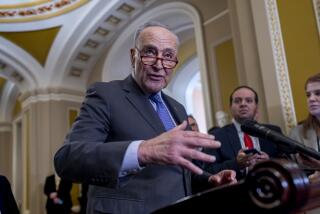Japan OKs $238-Billion Bank-Bailout Package
- Share via
TOKYO — Japan’s lawmakers gave final passage Monday to a $238-billion financial stabilization package, which lays the legal groundwork for Japan to try to restore health to its banking system. However, key details of how the plan will be implemented remain undecided.
The package includes elements that some analysts believe could eventually lead to a brutal banking industry shakeout along the lines envisioned by Prime Minister Ryutaro Hashimoto’s “Big Bang” financial system reform program.
Such an outcome would drive some weaker banks into bankruptcy and allow healthier banks to strengthen their positions, both domestically and internationally.
The package allots $135 billion to guarantee savings deposits at weak institutions that are allowed to fail. The deposit insurance is expected to ease the political and economic fallout of allowing dying banks to fail.
The second part of the legislation, however--funded by the package’s remaining $103 billion--would pave the way for a potential bailout of weak banks. The funds would be used to boost banks’ capital through such means as government purchase of banks’ stocks. This could provide short-term support for the economy but in the long run delay efforts to restore Japan’s overall financial system to better health.
There was little immediate impact in stock and currency markets of the plan’s passage into law by the Upper House of Parliament, which came after approval earlier this month by the Lower House.
The Nikkei-225 index closed Monday at 16,775.52, down 15.49 points, or .09%. The dollar was trading at 126.2 yen Monday afternoon in Tokyo, up 1.48 yen from Friday. Traders attributed this moderate weakening of the yen to doubts that the government will come up with any unexpected measures in an economic stimulus package due to be announced Friday.
“There’s no impact on markets since everyone knew what the package was all about,” said Junji Ota, an analyst at Okasan Research Institute. “However, I think this law should be appreciated. If some bank goes bankrupt . . . now there are solid laws to deal with that kind of situation.”
Japan’s banking system is burdened with massive bad loans. Last month, its Finance Ministry estimated the number of nonperforming loans at more than $215 billion. An additional $500 billion in loans is at risk of turning bad, it said. The two categories combined equal nearly 15% of the banks’ total loans.
One purpose of the stabilization package is to ensure that there is no chain reaction, where one bank’s failure leads to the collapse of other institutions.
But there’s uncertainty over the package’s practical effects because no one knows which banks will receive support from the second part of the package. If most capital goes to banks that are relatively strong, then consolidation of Japan’s financial system could be accelerated.
But if most support goes to keep unhealthy banks from failing, then any shakeout would be much less severe. Such a situation would be in keeping with Japan’s traditional banking system, where strong institutions are required to help the weak.
The new legislation creates a seven-member examination committee that will have discretionary power to determine which banks will receive support. The panel, which will include three members from outside the government, is empowered to draw up its own guidelines on how to apportion the funds.
Decisions to inject capital through buying banks’ stocks or other debt instruments must be approved by unanimous vote of the committee. Financial institutions receiving support must also win unanimous committee approval for “rationalization plans” designed to improve the soundness of their operations.
Vice Finance Minister for International Affairs Eisuke Sakakibara said recently that all of Japan’s top 19 banks will be eligible to apply for capital injections, and that smaller regional banks will also be eligible to get funds if they come up with acceptable restructuring plans.
Koichi Kato, secretary general of the ruling Liberal Democratic Party, has proposed that the examination committee divide banks into three ranks: strong, fairly strong and unhealthy, with the lowest classification barred from receiving bailout funds.
But there is some concern that under such a plan any banks given the lowest ranking might be quickly driven into bankruptcy. That could happen if investors rushed to sell stocks, other banks refused to provide funds and depositors withdrew their savings.
There are also concerns that if capital injections are targeted at solvent but relatively weak banks, those banks could be harmed by publicly labeling them as troubled. For that reason, there have been high-level suggestions that much of the initial funding should go to the strongest institutions, to remove any stigma from accepting the money.
“To encourage banks to apply for capital injection, the government will buy preferred stock, starting with banks in the best financial condition,” said Okiharu Yasuoka, chairman of the ruling party’s financial system stabilization subcommittee.
So far, only a few banks have indicated willingness to apply for capital injections. These include Bank of Tokyo-Mitsubishi, one of Japan’s biggest and strongest banks, and the much smaller Fukuoka City Bank and Bank of Yokohama. Nearly all other institutions are maintaining a wait-and-see attitude.
Etsuko Kawase of The Times’ Tokyo bureau contributed to this report.
More to Read
Sign up for Essential California
The most important California stories and recommendations in your inbox every morning.
You may occasionally receive promotional content from the Los Angeles Times.












